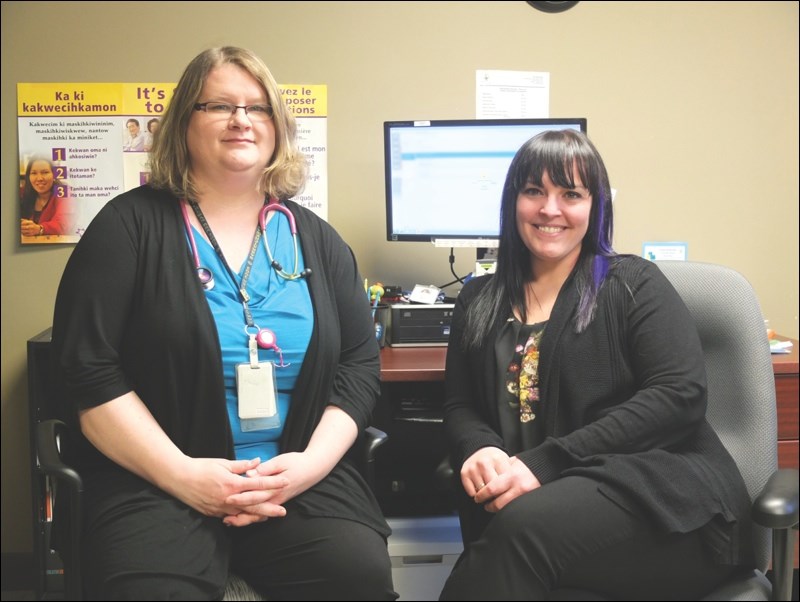A patient steps into Amy Sapergia Green’s inviting office on the third floor of the Flin Flon General Hospital.
After a meticulous discussion, and perhaps an examination, she settles on a diagnosis, makes out a prescription and recommends a follow up.
To a fly on the wall, Sapergia Green must be a physician. But rather than placing “Dr.” before her name, she puts two other letters after it: NP.
Sapergia Green is one of two nurse practitioners, along with colleague Angela Cable, now based at the hospital clinic. They are Flin Flon’s first NPs, highly educated nurses who have virtually the same authority as general-practice physicians.
“I’ve never considered being a physician,” says Sapergia Green. “I love nursing and am excited about what my nursing background allows me to bring to the people I care for.”
Holistic is the watchword for Sapergia Green, who strives to understand health challenges as part of a broader picture.
“I focus on the whole person and not just the issue that brought the patient in to see me that day,” says Sapergia Green.
Cable also endorses that approach. She views her role through the primary health care philosophy: the most appropriate care by the most appropriate provider at the most appropriate location.
“This, along with my personal nursing philosophy of harm reduction – meeting clients where they are at – [will] play a major role in how I [will] offer care to clients in our community,” says Cable. “I will support clients and families in making healthy choices to the best of their abilities as well as work collaboratively with other health care providers to provide quality enhanced care for our clients.”
Attracting patients
Since opening their clinic practices last year, Sapergia Green and Cable have had no difficulty attracting patients. Between them they have about 500 patients and are accepting more.
One of those patients is Helga Bryant, chief executive officer of the Northern Health Region and a long-time supporter of NPs.
“Anybody who has been to an NP will notice that there is a striking difference between how NPs relate to their patients and how physicians relate to theirs,” says Bryant. “Not that one is right and one is wrong [but that they relate] just [in] different ways because they come from different places. NPs come from a nursing place and just talk to their patients a bit differently and sort of look beyond just the immediate problem at hand.”
NPs also generally allot more time for patient visits than do general-practice physicians. As such, government guidelines call for NPs to carry peak patient loads that are one-third lower than those of family doctors.
“I have relatively long appointments, which allows me to spend a lot of time listening to the people who come to see me,” says Sapergia Green. “I also work really hard to meet people where they are at and partner with them to improve their health.”
Though NPs are inevitably compared to doctors, Sapergia Green sees their function as distinct.
“With any new role in a community, there’s bound to be some learning that goes with it and I often hear, ‘So you’re just a step down from a doctor now?’” says Sapergia Green. “I generally reply with, ‘No, we used totally different ladders to get here.’”
For Sapergia Green, a Flin Flon native, the first rung on that ladder was earning a nursing degree from the University of Saskatchewan in 2002.
She worked in neonatal intensive care in Saskatoon before moving back to Flin Flon a decade ago to become a public health nurse at the Primary Health Care Centre.
Last year Sapergia Green completed her Master’s degree in public health, allowing her to upgrade from an RN to an NP and start her own practice.
“NPs have more responsibility than RNs since our scope of practice includes the ability to diagnose disease, prescribe medication, order and interpret test results, and perform minor surgical procedures,” says Sapergia Green. “I believe anyone starting out as an NP will tell you the added responsibility can be a challenge to adjust to. At the same time, I find it very rewarding.”
Cable hails from Saskatoon, where she also earned her RN in 2002. She was employed at Saskatoon’s Royal University Hospital until 2005, when she moved to Cranberry Portage and worked as a public health nurse.
She later landed a job at Flin Flon’s Primary Health Care Centre. After completing her Master’s in public health last year, she too launched her clinic practice.
“Although my new role as an NP is both challenging and intense, I believe it will [bring] the lifelong reward of a career that has meaning and value to me,” says Cable.
Motivated
Cable was motivated to become an NP in part because of the limitations of registered nursing.
“There have been times in my nursing career that I have been unable to provide the care needed for my clients as it was beyond my scope of practice,” says Cable. “As such, I was inspired to become a nurse practitioner so that I might improve the overall health of my community.”
Although her practice targets all patients, Cable has a particular passion for women’s health, having previously been part of the women’s team at the Primary Health Care Centre.
“I noticed a gap in service to women’s health issues in our community and as such it inspired me to further my scope of practice and to better serve this area,” Cable says.
An intangible Sapergia Green brings to her practice is her long history with Flin Flon, where she was born and has spent most of her life.
“[I] love this community and the people in it,” says Sapergia Green, who is also a school trustee. “I’m excited to provide a service that I believe can make a difference.”
The Northern Health Region played a key role in the development of the new NPs, offering them financial assistance for school and leaves of absence from work.
Bryant says other Flin Flon RNs are interested in upgrading to NPs, but in order for that to happen the province must provide dollars for additional positions.
“It’s my goal to get increased funding,” says Bryant.
Though NPs are relatively new to Flin Flon, the concept dates back to the 1960s when the US health care system struggled with a doctor shortage. NPs now practice in 50-plus countries worldwide.




